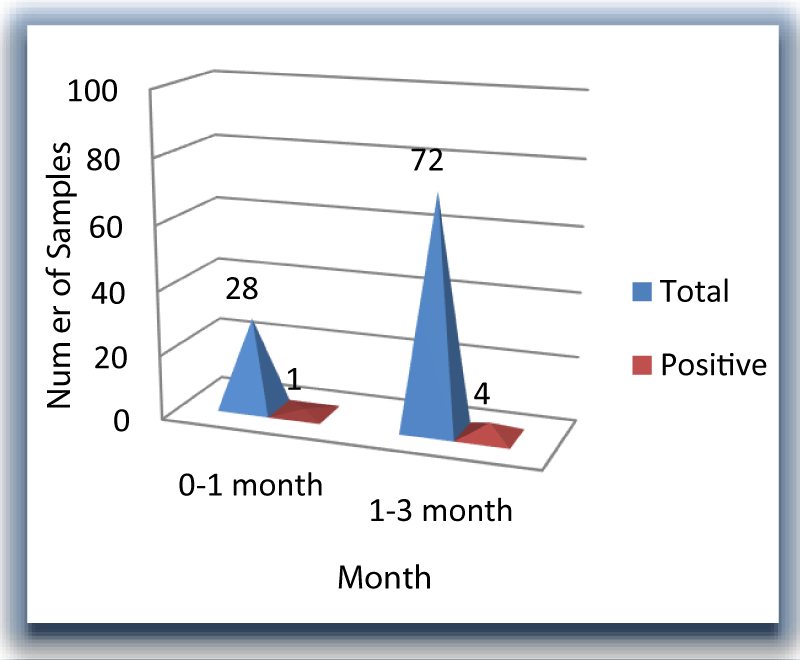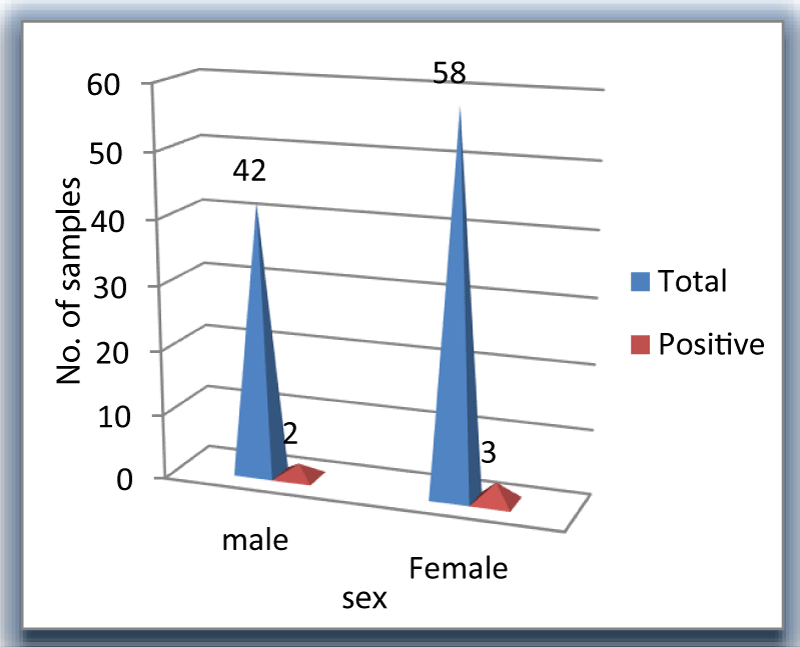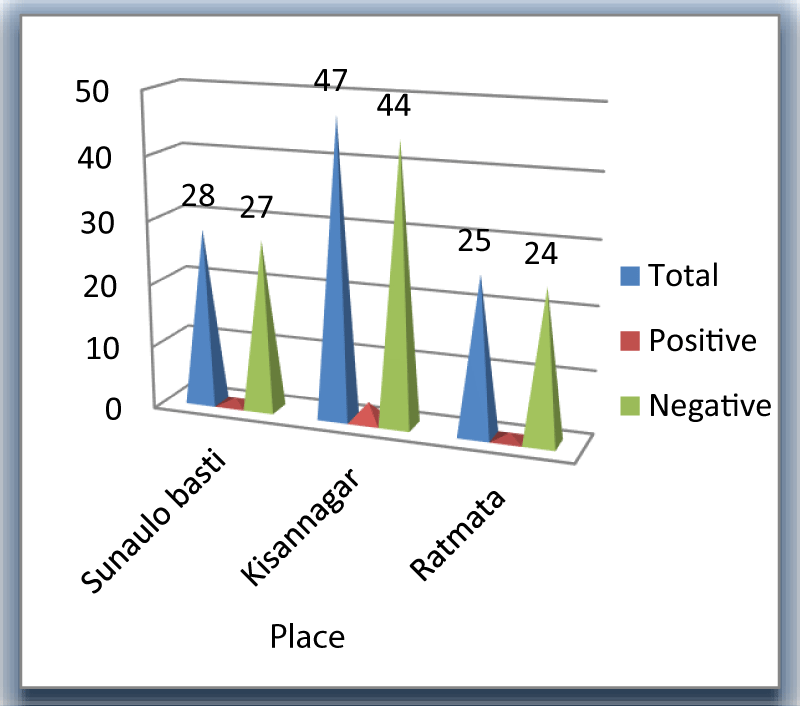International Journal of Veterinary Science and Research
Study on tapeworm infection in bovine calves of Bardibas Municipality, Mahottari
Neupane Dikpal1*, Sedhai Damodar2 and Singh Upendra Man3
2Adjunct Professor, Department of Veterinary Pathology and Meat Hygiene, HICAST, Kathmandu, Nepal
3Professor, Department of Veterinary Pathology, HICAST, Kathmandu, Nepal
Cite this as
Dikpal N, Damodar S, Man SU (2022) Study on tapeworm infection in bovine calves of Bardibas Municipality, Mahottari. Int J Vet Sci Res 8(1): 023-026. DOI: 10.17352/ijvsr.000107Copyright License
© 2022 Dikpal N, et al. This is an open-access article distributed under the terms of the Creative Commons Attribution License, which permits unrestricted use, distribution, and reproduction in any medium, provided the original author and source are credited.A study on Tapeworm infection in Bovine Calves of Bardibas Municipality, Mahottari district of Nepal was conducted during March – April 2021. A total of 100 fecal samples were collected from Ward No. 1,4 and 7 and examined in the laboratory as described by Soulsby, (1976). The laboratory examination was conducted at the Parasitology Laboratory of Himalayan College of Agricultural Sciences and Technology (HICAST). The overall prevalence of Moniezia spp. in bovine calves was found to be 5% (5/100). Based on the result, the prevalence of Moniezia spp. infestation in buffalo calves was found to be higher 8% (4/50) in comparison to Moniezia infestation in cattle calves 2% (1/50). The prevalence of Moniezia spp. according to the age group was found to be higher 5.56% (4/72) in the age group of 1-3 months compared to the age group of 0-1 month 3.57% (1/28). According to the location, the prevalence of Moniezia spp. the infestation was higher in Kisannagar at 6.38 % (3/47) in comparison with the Ratmata 4% (1/25) and Sunaulo Basti 3.57% (1/28).
Introduction
Nepal is a country where agriculture remains the main occupation dropping rapidly but still hovers around 65% population; livestock covers 32% of agricultural GDP and about 11.5% of the total country’s gross domestic product [1]. In Asia, cattle and buffalo played a pivotal role in overall social development through contributions to milk, meat, hides, horns, hair, and draft power [2]. Parasitic diseases caused by intestinal parasites constitute a major impediment to livestock production characterized by lower outputs of animal products, byproducts, manure, and power, thereby affecting the contributions of cattle and buffalo in ensuring food security, especially in developing countries [3]. Gastrointestinal parasitism is associated with economic losses, lowered productivity, reduced animal performance [4] and mortality and morbidity [5].
Moniezia spp. are the common gastrointestinal tapeworm found in ruminants in worldwide distribution [6]. The completion of the life cycle of Moniezia spp. requires oribatids as the intermediate hosts and ruminants as the definitive hosts [7]. Infection of the latter hosts is initiated by ingesting the infected mites containing Moniezia cysticercoids and the larvae develop to adult worms in the small intestine of ruminants and are responsible for the onset of moniliasis, resulting in gastrointestinal disorders [8]. At least 12 Moniezia species have been described in domestic and wild ruminants based on their relatively narrow set of morphological features [9]. Based on the shapes of their interproglottidal glands and eggs, Moniezia benedeni and M. expansa (2-4m) have been identified as distinct species with the former species having a short continuous linear pattern of interproglottidal glands and the latter species possessing a row of small circles-pattern of the interproglottidal glands [10]. Ohtori, Aoki & Itagaki [10] had explained that eggs of these parasites are tetragons in shape for M. benedeniand triangles for M. expansa, respectively.
Borges, et al . [11] studied “Helminth Parasites of cattle” taking a total of 42 Holstein and Zebu mixed breeding animals of 8-14 months and found 4.76 % Moniezia Benedetti positive after post-mortem examination. Kulišić, et al . [12]. Had found 3.17% positive cases of Moniezia spp. in calves out of 600 samples tested for gastrointestinal helminths, where the prevalence of infection for GI parasites was found to be 64.17% in western Serbia. Irie, et al . [13] reported the seasonal change in prevalence of Moniezia Benedetti with the highest rate in October 2011 (27.3%) followed by a gradual decrease until July 2012 (9.4%) in Confined Cattle possibly maintained by an Intermediate Host on the Farm in Japan.
Cattle and buffaloes are economically important food-producing animals in Nepal. Internal parasitism causes stunted growth and delays in puberty in young calves. This ultimately is expressed in terms of decreased fertility and production. Unfortunately, very limited data are available related to the prevalence of Moniezia spp. infestation in calves in Nepal. Hence this study was carried out to find out the Moniezia spp. load in bovine calves (less than 3 months of age) in Bardibas municipality of Mahottari district. The study was conducted in a particular area of Mahottari district within the specified time period and the coverage or number of samples was small. No effort was made to find out the prevalence of this parasite in adult cattle and buffaloes.
Materials and methods
Study area, sample collection and preservation
The study site of this research was Bardibas municipality of Mahottari district of Province number 2, covering Kisannagar, Ratmata, and Sunaulo Basti. A total of 100 (50 each from cattle and buffalo calves) fecal samples were collected from cattle and buffalo calves directly per rectum and transported to Parasitological Laboratory of HICAST in an icebox and preserved in a refrigerator.
Materials used and laboratory examinations
Materials used in this study were fecal samples, microscope with 10X magnification (Olympus, Japan), weighing balance, mortar and pestle, beakers, sieve, gloves, test tubes, and test tube stands. A qualitative method of fecal examination (flotation and sedimentation method) was followed to identify the eggs of parasites as described by Soulsby [14].
Sedimentation technique
Approximately 3g of feces was taken and homogenized using mortar and pestle. Some water was added and poured in a beaker to the top using a sieve discarding the debris. The filtrate was allowed to stand for 5 minutes in a beaker. The supernatant was removed. Adding water and discarding supernatant was followed repeatedly until the suspension became clear. Finally taking the few drops of sediment on a glass slide covered with a coverslip was observed under the microscope in 10× and 40× power.
Flotation method
About 3g of feces was homogenized adding a few drops of water using mortar and pestle and poured in a beaker using a sieve. A few ml of filtered sample was mixed with 50ml of saturated NaCl solution in a test tube. This test tube was placed in a test tube stand and a coverslip was gently placed on the top of the test tube. After 20 minutes coverslip adhering with fluid was placed on the glass slide for the identification of Moniezia ova under the microscope with 10× and 40× power.
Statistical analysis
Simple statistical tools were used for data analysis. The data obtained were expressed in percentage and presented in pie chart and bar chart.
Results and discussion
Farming practice
A mixed farming system had been practiced in Bardibas municipality as in most of the Terai district of Nepal. Most of the farmers adopt the partial grazing system and some practice stall feeding. Natural and cultivated green grasses are the prime source of forages in the rainy season while fodder trees are the major source of animal feed in winter.
Farmers were treating their livestock only after finding some symptoms of endo-parasitism such as diarrheic feces, debilitated body condition, less body weight gain, anorexia, and lowered milk yield. Most of the farmers do not deworm their calves because they are not productive at that stage and in most cases weaning of calf occurs naturally when the dam’s production ceased.
Prevalence of Moniezia species
Out of 100 fecal samples, only 5 (5%) samples were found positive for Moniezia spp. Whereas 95 (95%) samples were found to be negative.
Age wise prevalence of parasites
The ages of the calves were classified as early birth (0-1 month) and young (1-3 months). The prevalence of Moniezia spp. infestation in absolute figures reflects a higher occurrence in 1-3 months age group as 5.56% (n= 72) than 0-1month) age group as 3.57% (n= 28) as shown in Figure 1.
Sex - wise prevalence of parasites
Samples were collected from the male (n= 42) and female (n= 58) bovine calves and tested. The prevalence of Moniezia spp. in female calves was found slightly higher (5.17%) compared to that of male calves (4.76%) as shown in Figure 2.
Area - wise prevalence of parasites
Area wise the samples were collected from 3 different villages of Bardibas municipality, namely, Sunaulo Basti, Kisannagar, and Ratmata. Kisan Nagar showed a higher prevalence (6.38%, n= 3/47) while Sunaulo Basti showed a less prevalence (3.57%, n= 1/28) and prevalence percentage in Ratmata was (4%, n= 1/25) as shown in Figure 3. The difference may be due to no or long interval of deworming, repeated grazing and cutting grass for stall feeding on the same pasture, improper management of manger, contamination of calves grass and licking of feces contaminated shed- dust, etc. might be the reason for the Moniezia spp. infestation in calves.
Comparison between species
50% samples were collected from cattle calves and 50% samples were taken from buffalo calves. Based on the result prevalence of Moniezia spp. in buffalo calves was found to be higher (8%, n= 50) than that found in the cattle calves (2%, n= 50) as shown in Figure 4. This study revealed that the population of cattle reared in a shed in Bardibas municipality was less than that of buffaloes. Mostly one household reared one or two local cattle but there were more local and Indian crossbreed buffaloes. It seems that local cattle calves are comparatively less sensitive to Moniezia infestation than crossbreed buffalo calves and cattle calves are reared individually in most households. This may be the reason that cattle calves have less Moniezia spp. infestation than in buffalo calves.
Discussion
Comparing the result of this study with other international studies related to the gastrointestinal parasite may not have great significance because other studies reviewed for this research didn’t make any effort to find out the Moniezia spp. specifically. Although the sample size was not similar, the difference in the ratio of the result may have some relationship.
Internal parasitism is associated with economic loss, lowered productivity [4], morbidity and mortality [5] and growth and weight gain [7] in the affected animals. The overall prevalence of Moniezia spp. in cattle and buffalo calves in the present study is found 5% which is almost similar to that found by Borges, et al . [11] in Brazil (4.76%) and a little bit higher than that reported by Kulišić, et al . [12], which was 3.17%. The reason for different results might be due to differences in the geographical plot and ecological conditions such as altitude, rainfall, season, and temperature.
Present findings greatly differed from the results reported by Irie, et al . [13], who had reported 27.3 % in October and 9.4 % in July. Such difference in the results might be attributed to the seasonal variation in the activities of the intermediate host (Oribatid mites), feeding / pasturing, or husbandry practice in calf rearing. In addition, this study was conducted only in March and April months, whereas Irie et al . (loc. cit.) had taken about 10 months time for a comparative study. As the present study was conducted in the dry season the prevalence of Moniezia spp. might have been recorded less than that reported by Irie, et al . (loc. cit.) during July (9.4%).
While analyzing the age-wise, sex-wise, species-wise, and area-wise prevalence of Moniezia spp. in the targeted animals, sex-wise prevalence did not differ much (i.e. 5.17% in females and 4.76% in males calves), indicating that both sexes are almost equally sensitive to infestation.
Lower prevalence rate (3.57%) in the early-born calves of 0- less than 1 month when compared to that in the calves of 1-3 months of age (5.56 %) might be attributed to less grass-feeding habit in the calves of less than one month of age. Besides, there is no or little chance of getting Moniezia infestation via milk. As the calf grows older, it consumes more grasses, goes for pasture feeding, drinks contaminated water, and licks contaminated soil if kept in one place for a long time without giving grasses, there will be more chance of getting an infestation of Moniezia spp.
As buffalo calves go to the wet or swampy area for grazing or wallowing, which is not true for cow calves, this might be the major cause of getting a higher rate of positive cases (8.0%) compared to that in the cow-calves (2%).
The prevalence rate of Moniezia sp. differed from place to place (Kisannagar, 6.38%; Ratmata, 4%; and Sunaulo Basti, 3.57%). The difference might be due to no or long interval of deworming, repeated grazing and cutting grass for stall feeding on the same pasture, improper management of manger, contaminated grass with feces, and licking of feces contaminated with the shed- dust.
The major significance of this research is i) it can help farmers of this particular place to know about the economic loss in calves due to the Moniezia spp. infection; ii) it can create the idea about its further research to the new veterinarians taking more samples in a large population; iii) it helps the farmers and researchers to realize that deworming against the tapeworms is also beneficial to promote the growth of calves and to minimize economic loss due to this neglected parasite; iv) finally it can provide tentative idea about the prevalence of Moniezia spp. in calves.
Conclusion and suggestions
The overall prevalence of Moniezia spp. in bovine calves of Bardibas municipality of Mahottari district was found to be (5%). The infection of the Moniezia spp. will certainly have a great impact on the health, production, and productivity of bovines. Based on the findings of the study, few suggestions are made: i) Management system should be improved; farm separation; ii) Sanitation and make availability of nutritious food to the animals; iii) If possible - rotational grazing and stall feeding management practice should be adopted; iv) Appropriate deworming schedule should be followed to prevent or lower the level of parasitic infections or load; v) The suckling calf should be kept on a clean hygienic floor and proper feeding of colostrum after birth is much more essential to boost up the immunity against different parasitic diseases as well; vi) Farmers should be encouraged for fecal examination routinely (interval of 3-6 months) before deworming their stocks; vii) Farm should be made in such way that direct sunlight can dry the shed of cattle, buffalo and their calves so that distribution of intermediate host in shed can be reduced; viii) Mites primarily reside in moist soil and decayed grasses so the floor of the farm should be made with concrete; ix) Further research may be needed on this topic with a larger sample size to get the actual prevalence rate in the population.
- Bhatta BR, Kaphle K, Yadav K (2018) Situation of Livestock, Production and its Products in Nepal. Arch Vet Sci Med 01: 1-8. Link: https://bit.ly/3sheJe8
- Nanda AS, Nakao T (2003) Role of buffalo in the socioeconomic development of rural Asia: Current status and future prospectus. Anim Sci J 74: 443-455. Link: https://bit.ly/3Hh7Pdt
- Gunathilaka N, Dimuthu N, Amarasinghe D, Udayanga L (2018) Prevalence of Gastrointestinal Parasitic Infections and Assessment of Deworming Program among Cattle and Buffaloes in Gampaha District, Sri Lanka. Biomed Res Int 2018: 3048373. Link: https://bit.ly/3Hgs4rt
- Badran I, Abuamsha R, Aref R, Alqisi W, Alumor J (2012) prevalance and diversity of gastrointestinal parasites in small ruminants under two different rearing system in jenin district of palestine. An Najah Univ J Res 26: 1-18. Link: https://bit.ly/3ha94QL
- Negasi W, Bogale B, Chanie M (2012) Helminth Parasite in Small Ruminants: Prevalence, Species Composition and Associated Risk Factors in and Around Mekelle Town, North Ethiopia. Biol Sci 4: 316–319. Link: https://bit.ly/3HilNM1
- Foreyt WJ (2001) Veterinary Parasitology Reference Manual. 5th edn. Blackwell. Link: https://bit.ly/3Iin7Qo
- Perri AF, Mejía ME, Licoff N, Lazaro L, Miglierina M, et al . (2011) Gastrointestinal parasites presence during the peripartum decreases total milk production in grazing dairy Holstein cows. Vet Parasitol 178: 311–318. Link: https://bit.ly/3LVfzFm
- Diop G, Yanagida T, Hailemariam Z, Menkir S, Nakao M, et al. (2015) Genetic characterization of Moniezia species in Senegal and Ethiopia. Parasitol Int 64: 256-260. Link: https://bit.ly/3BTteIr
- Kaisheng W, Jirong L, Xinwen B (2010) Comparison of the morphology of Moniezia benedeni and Moniezia expansa. Xinjiang Agricul Sci 47: 612–618. Link: https://bit.ly/3veTL1A
- Ohtori M, Aoki M, Itagaki T (2015) Sequence differences in the internal transcribed spacer 1 and 5.8s ribosomal RNA among three Moniezia species isolated from ruminants in Japan. J Vet Med Sci 77: 105-107. Link: https://bit.ly/3sYyFSm
- Borges F, Miyasaka da Silveira D, Neves EBN, Castagnolli KC, Soares VE, et al. (2001) Fauna Helmintológica de Bovinos da Região de Jaboticabal, Estado de São Paulo, Brasil. Semin Cienc Agrar 22: 49–53. Link: https://bit.ly/3pcxXzH
- Zoran K, Aleksic N, Djordjevic MM, Gajic B, Tambur Z, et al. (2012) Prevalence of gastrointestinal helminths in calves in Western Serbia. Acta Vet 62: 665-673. Link: https://bit.ly/3p8wb2Q
- Irie T, Sakaguchi K, Ota-Tomita A, Tanida M, Hidaka K, et al. (2013) Continuous Moniezia benedeni Infection in Confined Cattle Possibly Maintained by an Intermediate Host on the Farm. J Vet Med Sci 75: 1585-1589. Link: https://bit.ly/33Kfino
- Soulsby EJL (1976) Helminths, Arthropods and Protozoa of Domasticated Animals. 6th edition. Edited by T. E. L. B. S. and Baillere. Tindall and Cassell Ltd.
Article Alerts
Subscribe to our articles alerts and stay tuned.
 This work is licensed under a Creative Commons Attribution 4.0 International License.
This work is licensed under a Creative Commons Attribution 4.0 International License.





 Save to Mendeley
Save to Mendeley
